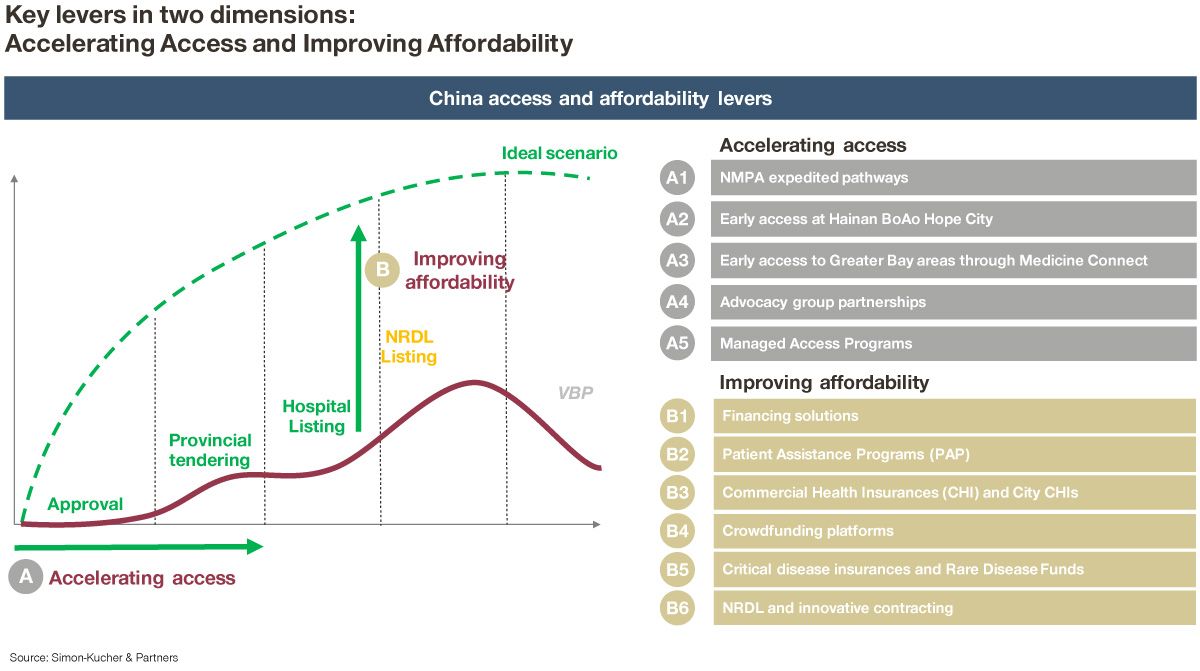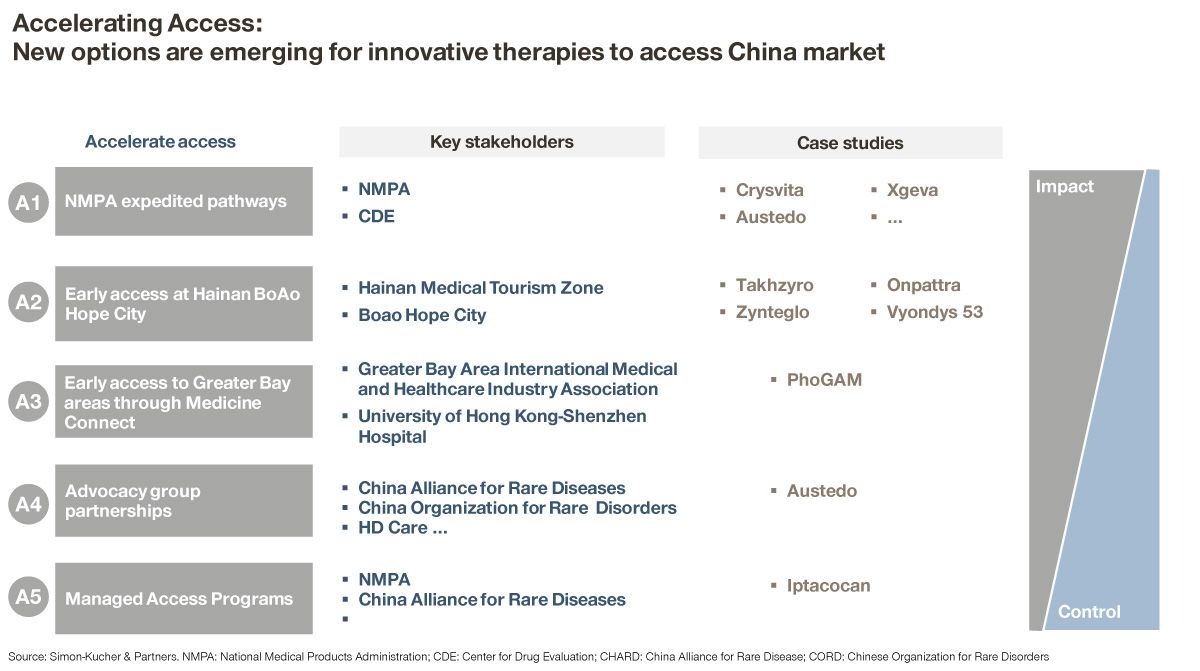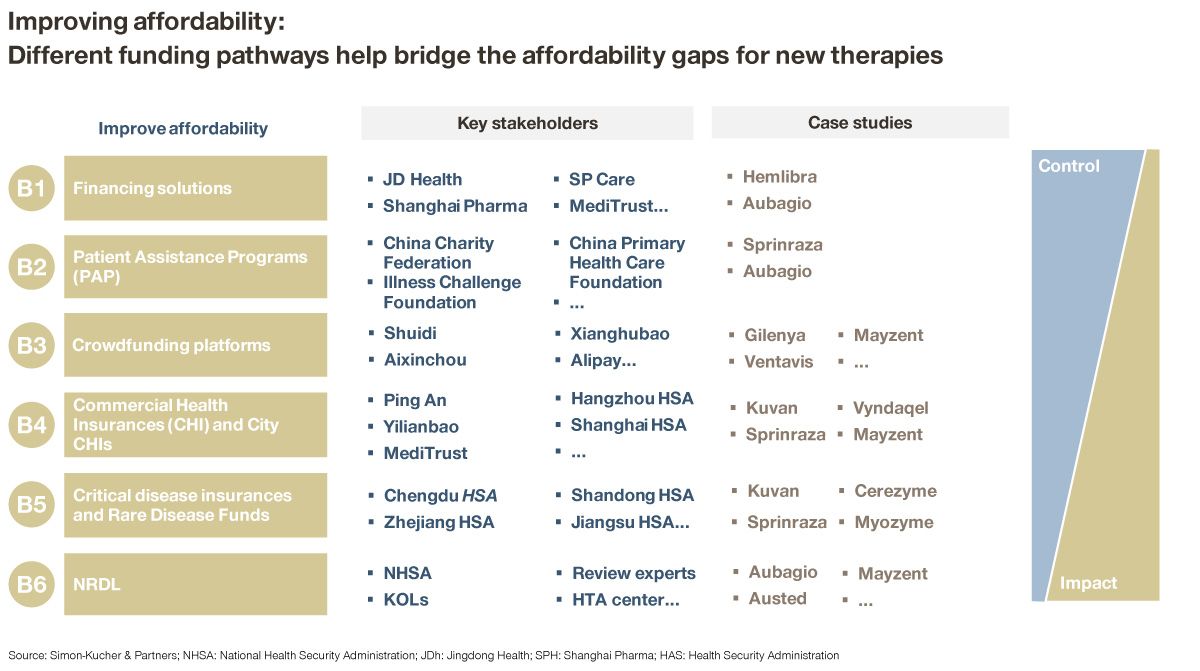- Sustainability
- DE&I
- Pandemic
- Finance
- Legal
- Technology
- Regulatory
- Global
- Pricing
- Strategy
- R&D/Clinical Trials
- Opinion
- Executive Roundtable
- Sales & Marketing
- Executive Profiles
- Leadership
- Market Access
- Patient Engagement
- Supply Chain
- Industry Trends
Maximizing China Access for Innovative Therapies
Chinese market access environments are dynamic and fast changing, and a number of new access and affordability options are emerging. To maximize the potential of innovative therapies, it is important to have a holistic view of the full range of options and levers, prioritize and sequence the ones with the highest impacts, and develop an integrated strategy tailored to address China’s unmet needs.
Access and affordability have always represented major hurdles for innovative therapies in China. In stark contrast to the uptake curves for new launches in many markets, a typical China trajectory features much slower initial uptake – impeded by market access challenges like provincial tendering and hospital listing, as well as patient affordability gaps. As a result, the lifecycle curves for many innovative therapies tend to be constrained and compressed, and fall short in delivering the great promise and full potential oftentimes expected of them.
Building on Simon-Kucher’s extensive market access experience in China over the years, we have identified a number of actionable levers to overcome the challenges along two key dimensions: accelerating access, and improving affordability.
Click to enlarge

Accelerating access for innovative therapies
A number of recent developments have made it possible to accelerate market access in China, and, in some cases, early access to pockets of the Chinese market even before the formal regulatory approval by the National Medical Products Administration (NMPA), which in turn helps with the approval process.
Click to enlarge

- The Hainan Boao Lecheng International Medical Tourism Pilot Zone, also aptly known as Hope City, has been one of the top destinations for many innovative therapies coming to China recently
- Endowed with power from the State Council, Hope City has the unique opportunity to treat patients with drugs, devices, and innovative therapies approved overseas, but not yet approved in China
- Takhzyro, or lanadelumab from Takeda — a plasma kallikrein inhibitor indicated to prevent attacks of hereditary angioedema (HAE) — made its way to Boao Lecheng Weijian Rare Disease Clinical Medicine Center shortly after its FDA approval. This helped its NMPA approval in December 2020
- More recently, innovative therapies can also expect approvals through real world data (RWD) generated at the pilot zone. Pralsetinib – a RET inhibitor from Blueprint Medicines with CStone as a partner in China – was approved in March 2021 with RWD from Hope City
- The Medicine Connect program is a similar pilot for the Greater Bay area endorsed by NMPA and seven other regulatory bodies
- In March 2020, a list of 54 drugs and medical devices approved in Hong Kong and Macau for oncology, rare diseases, and other urgent conditions was submitted by Hong Kong University Shenzhen Hospital for access to the area, including nine major cities in Guangdong
- In April 2021, RhoGAM (anti-D immune globulin) became the first therapy approved for use in the Greater Bay area through the Medicine Connect program, paving the way for early access to innovative drugs approved in Hong Kong but not yet available in mainland China
- Patient advocacy groups(PAGs) like China Alliances for Rare Diseases (CHARD), Chinese Organization for Rare Disorders (CORD), and others for particular diseases are emerging in China as important influencers in many ways
- HD Care – a Huntington’s disease patient group – sent over 100 letters to the NMPA and National Health Security Administration (NHSA) to communicate the unmet needs of Chinese patients
- Huntington’s disease was subsequently included in the first batch of the China rare disease catalogue, and Teva’s Austedo was included in the first batch of the Overseas New Drugs Urgently Needed (ONDUN) list in China. 18 months later, Austedo received NMPA approval, and was then included in the 2020 National Reimbursement Drug List (NRDL) within another seven months
- Going forward, partnerships with PAGs will have an increasingly important role to play in connecting with patients, facilitating clinical trials and access, as well as shaping regulatory and reimbursement policies and priorities
- Managed access programs (MAPs) offer the latest new route for early access in China
- MAPs generally refer to expanded and compassionate use of yet-to-be-approved therapies for patients who are not enrolled in a clinical trial
- Per Article 23 of China’s new Drug Administration Law, compassionate use is permitted after Institutional Review Board, or Independent Ethics Committee(IRB/IEC)approval. However, this is still limited to hospitals hosting the clinical trial
- In June 2021, Iptacopan for paroxysmal nocturnal hemoglobinuria (PNH) became the first drug through the Novartis MAP, with blessings from NHC (National Health Commission), NMPA and CHARD, and carried out by Peking Union Medical College Hospital, the leader of the rare diseases hospitals network
Access options like these help innovative therapies get to Chinese patients early, and sometimes well ahead of NMPA approval. This window of early access is valuable, in garnering goodwill and KOL support, as well as Chinese data and real world evidence, which are key for the eventual approval.
Moreover, some of the programs will continue to play key roles upon formal approvals and commercial launches in China, and would go a long way to accessing the Chinese market, as well as reaching patients in need.
Improving affordability for high-priced therapies
Innovative therapies typically come with big price tags, posing significant affordability challenges to many patients and their families in need. To bridge the affordability gap, the full range of funding pathways should be taken into account, aimed at developing multi-channel solutions for the patients in need.
Click to enlarge

- To start with, Direct-to-Patient (DTP) financing solutions could mean a lot for patients. For example, it could help them manage the cost burden, while improving initial adoption and subsequent adherence
- Roche entered a strategic partnership with Shanghai Pharma to bring Hemlibra to hemophilia patients through financing and cash back schemes, which proved to be highly effective
- Pharmacy Benefit Managers (PBMs) like MediTrust and SP Care could play an important role in designing the financing schemes. MediTrust, for example, launched the “Kangfu-Clover Rare Disease Care Center” in June 2021, to provide innovative financing and service solutions for rare disease patients
- Online health majors are also moving in that direction, and JD Health launched its “Rare Disease Care Center” in February 2021, aiming to offer a one-stop solution platform for patients in need
- The Patient Assistance Program (PAP) has long been in place in China. It requires close collaborations with charity foundations like China Charity Federation (CCF) and China Primary Health Care Foundation (CPHCF) for effective reach and disbursements
- Spinraza, the innovative spinal muscular atrophy (SMA)therapy from Biogen, launched its PAP working closely with the CPHCF. It alleviated qualified patients from 87 percent of the cost burden for the first year with loading dose, and 74 percent of the cost burden for subsequent years with maintenance doses
- In its rollout first phase, from May 2019 to December 2020, the Spinraza PAP reached over 120 SMA patients.At the same time, it laid the groundwork for following phases, and other funding pathways
- CPHCF also spearheaded a number of initiatives and PAPs for critical diseases and rare diseases. This included the one for multiple sclerosis, which resulted in a40 percent reduction of drug costs for most patients, and made drugs available to qualified low-income patients
- Crowdfunding platforms started out as online peer-to-peer (P2P) patient support programs. Some have evolved toward membership models to provide coverage for patients in need
- One of the platforms, Shuidi, has built its leading position as an early mover, and has served over 1.7 million patients with P2P support
- More recently, Shuidi launched a membership model for paid members, and offers drug discounts and partial coverages for cancer, and rare diseases like ALS, PAH and multiple sclerosis
- Another major platform, Xianghubao, features a similar program with broader coverage for rare diseases including: ALS and PAH, as well as HEM, MPS, MG and SMA etc.
- Commercial Health Insurances (CHIs) have been in China for decades in many varieties. City CHIs are the latesttype, and have been gathering strong momentum:
- With the first pilot in Shenzhen, City CHIs have taken off over the past couple of years in 200 major cities across China, typically featuring the public-private partnership (PPP) model operated by commercial insurances with strong endorsement from local governments, and tailored coverage schemes to address the specific unmet needs of their local citizens
- As a latecomer to the game, Shanghai launched its own version of CHI in May 2021, but optimized the design, and rollout based on learnings from other city CHIs. It featured a specialty drug formulary including 16 oncology drugs and 5 rare disease drugs, such as Huntington’s and Fabry disease. Within two months of launch, it enrolled 7 million residents – 37 percent of the city’s population
- To date, different archetypes of City CHIs have emerged across China, and evolved to be more open and inclusive to patients with pre-conditions. Meanwhile, City CHIs have also optimizedformulary, premium, deductible, and payout schemes to simultaneously ensure economic viability, and sustainability
- Going forward, City CHIs will play an increasingly important role supplementing public reimbursements, while opening up new opportunities for innovative therapies as the formularies get updated on an ongoing basis
- Critical disease insurances (CDIs) and rare disease funds in contrast are typically led by public payers at a regional level, and provide coverage for critical diseases and rare diseases:
- Zhejiang was among the first to evolve its CDI towards the rare diseases fund. Besides Cerezyme and Kuvan that fall under its CDI coverage, Fabrazyme and Myozyme are also included
- In 2021, Cerezyme, Fabrazyme, Myozyme and Replagal were included in the Shandong CDI coverage
- In March 2021, Chengdu launched its rare diseases scheme with a slightly different coverage and a larger formulary. It included Cerezyme, Kuvan and Myozyme, as well as Spinraza, Vimizim, Treprostinil, and Vyndaqel
- In July 2021, Jiangsu released its first batch of rare diseases coverage, with Cerezyme, Myozyme, Fabrazyme, Replagal, Spinraza, and Vimizim making it into the formulary
- More recently, there have been new initiatives spearheaded by CHARD to explore national reimbursement for priority rare disease therapies, signaling a potential shift of rare disease coverage from regional to national level
- Last but not least, the NRDL remains the most important reimbursement mechanism with nationwide coverage and highest impact. It has been increasingly open and inclusive to innovative therapies:
- 2020 marked a record year for the entry of innovative drugs into the NRDL, with 17 drugs approved in the same year making it to the final list. This included vendolizumab from Takeda, siponimod from Novartis, as well as tislelizumab and Inetetamab from local biopharmas BeiGene and 3S Bio, respectively
- The 2021 NRDL has been unfolding since June this year, with ongoing emphasis on innovations as we noted in our 2020 NRDL Outlook
- Of the 172 new entries that passed the 2021 formal review, 93 drugs were newly approved since 2020. Moreover, many innovative drugs, from both multinational companies and local biopharmas, are currently making their way to the finish line, heralding another record-breaking year in many ways
In summary, China’s access environments are dynamic and fast changing, and a number of innovative access and affordability options are emerging. It is noteworthy though, that each of the options feature distinct impact, control, attractiveness, and feasibility.
Furthermore, none would be a silver bullet on stand-alone basis. To make the best of these, it takes a patient-first mindset above all, as well as a systematic approach to prioritize the right ones, and an integrated strategy tailored to address the unmet needs of Chinese patients. As a result, pharma companies would be well-positioned to maximize the value, impact, and full potential of the innovative therapies they bring to China.
About the authors
Bruce Liu leads Simon-Kucher’s Life Sciences division in Greater China. Josh Lee is a project manager with years of experience in China pharmaceutical pricing and access strategies. Justin Liu is a senior consultant specialized in China pharma and healthcare industry. Duo Xu, Miranda Wang and Selene Peng are consultants with experience across diverse therapeutic areas, and recent experience on NRDL and innovative access options in China.
